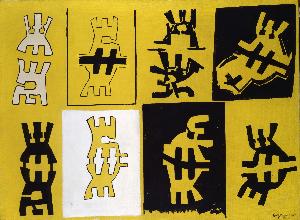Giuseppe Capogrossi
Giuseppe Capogrossi;Capogrossi
Place: Rome
Born: 1900
Death: 1972
Biography:
Giuseppe Capogrossi was an Italian painter born in Rome in 1900. He obtained a degree in law in 1923-1924 and then studied painting with Felice Carena at the Accademia di Belle Arti di Roma. In 1927, he embarked on a formative trip to Paris with fellow artist Fausto Pirandello. Capogrossi participated in many group exhibitions in Rome, Venice, Milan, and Paris in the 1930s.
Early Career and Influences
Capogrossi's early work was influenced by the Italian Renaissance and the works of Raphael (Raffaello Sanzio Da Urbino). He was also inspired by the modernist movement, which emphasized experimentation and innovation in art. Capogrossi's unique style blended traditional techniques with modern expression, making him a prominent figure in the Italian art scene.
Artistic Style and Contributions
Capogrossi's artistic style is characterized by bold brushstrokes, vibrant colors, and expressive compositions. His work often featured abstract elements, which were a departure from the traditional representational art of the time. Capogrossi's contributions to the Italian art scene include his participation in the 23rd edition of the Venice Biennale in 1930 and his signing of the Manifesto del Primordialismo Plastico in 1933.
- Pinacoteca di Vicenza: Capogrossi's work can be found in this museum, which houses an impressive collection of artworks from various periods and styles.
- Pinacoteca di Vicenza, Italy: This article provides more information about the museum and its collections.
- Giuseppe Capogrossi: A biography of the artist can be found on Wikioo.org, which features his artworks and provides information about his life and career.
Later Work and Legacy
After World War II, Capogrossi's work changed in favor of a more abstract style. He became one of the main exponents of Italian informal art, together with Lucio Fontana and Alberto Burri. Capogrossi died in 1972, leaving behind a legacy of innovative and expressive artworks that continue to inspire artists today. In conclusion, Giuseppe Capogrossi was a talented artist who made significant contributions to the Italian art scene. His unique style and experimentation with modern techniques have left a lasting impact on the world of art. Art Movements provides more information about the various styles and movements that influenced Capogrossi's work, while Timeline offers a comprehensive overview of art history.


